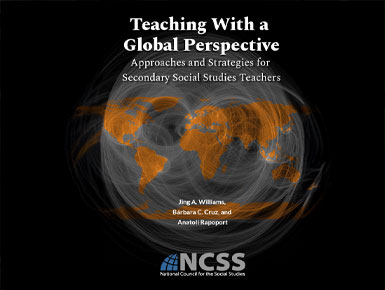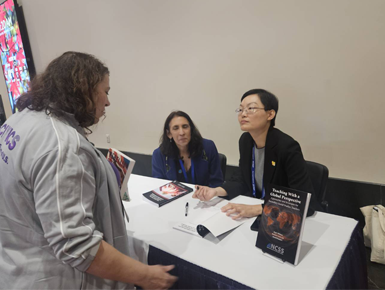USD's Jing Williams Publishes Book Through the National Council for the Social Studies

The book, “Teaching With a Global Perspective: Approaches and Strategies for Secondary Social Studies Teachers,” highlights the importance of teaching social studies with a global perspective and teaching strategies that teachers can implement in their classrooms.
Williams sat down with us for a conversation about her book and the impact it will have on social studies classrooms.
What inspired you to write the book?
My research has focused on a global perspective of social studies education since I was a doctoral student. I have actively taken leadership roles in my professional organization – the International Assembly, an associated group of the NCSS. One day, the NCSS Director of Publication reached out to me and gauged my interest in writing a book on global studies education.
I was thrilled because the NCSS only asks experts in the field to author their books. I accepted and then found two colleagues, who are also famous global scholars, to work on the book with me.
Can you describe the key takeaways or specific strategies and approaches outlined within the book?
The book chapters are organized around social studies content areas most commonly taught at the secondary level in U.S. schools: U.S. History, World History, Geography, Civics and Government, Economics, Social and Behavioral Sciences and Contemporary Events.
In each chapter, we chose some frequently taught topics as case studies and showed teachers how to teach those topics with a global perspective. Some of the featured strategies include discussion of stratified questions, small group collaborations, oral history interviews, the See-Think-Wonder approach, mock elections, student theater, peer teaching and more.
How does this book address any challenges teachers may face in this day and age?
One of the biggest challenges for social studies teachers today is to teach from a global perspective. Research has shown that U.S. history textbooks are generally U.S.- or Euro-centric. While it is a good thing to ensure our youth understand our nation’s history, the U.S.-centric approach does not give our students a holistic understanding of the world they are living in. If the teachers don’t have a global awareness, how can we expect our future generations to understand the world and become the leaders of the future?
Why is it crucial for social studies education to incorporate a global perspective?
Our world has never been as connected as it is today. International trade, instantaneous communications, pandemics, global supply chain disruptions due to regional conflicts – all these are just a few global issues that intersect daily with our students’ lives. If we expect our students to be globally aware and become future leaders with problem-solving skills, our curriculum must reflect our current global realities.
How does teaching with this perspective benefit students’ understanding of the world and their place in it?
As a citizen, we are responsible for our country’s well-being. At the same time, living in an interdependent world, I feel we also have a responsibility to our Mother Earth.
When teachers teach and intertwine it with a relatable topic of interest, they can easily incorporate said topic in the lesson, while introducing just how that topic has taken on human and environmental tolls. By teaching this way, our students understand how their habits can affect people in other parts of the world. Naturally, they will start thinking what they can do to make a difference in the world.
How does this foster critical thinking and other essential skills in students?
Critical thinking is embedded in every chapter of the book.
For example, in the economics chapter, one topic is “Are My Hands Clean?: Ethics in the Economic Supply Chain.” Global economy makes our lives easier. But when certain products, such as clothes and fruits, are produced by violating human rights in different parts of the world, what can we do to make things better?
We can teach these important lessons to our students by asking them to analyze posters and news reports, do research on certain products in small groups, find solutions, and present their findings to the rest of the class. This learning process emphasizes key life skills: critical thinking, collaboration, research, problem solving, peer teaching, and public speaking.
What kind of feedback/response have you gotten upon the publishing of this book?
Many teachers embrace the book because they are looking for ideas to incorporate a global perspective in their teaching. During the book signing session at the NCSS conference last November, teachers and educators bought the book and told us they were waiting for something like this book to be used in their classroom. Some teachers bought the book for their colleagues who they knew liked to teach with a global perspective.
What advice would you give to teachers who are eager to incorporate a global perspective into their classrooms but may feel unsure where to begin?
This book is a good starting point as it gives teachers many ideas and strategies they can use directly in their classrooms. It requires the teachers to pay attention to the events happening in the world and find a connecting point to the subject taught in class.
Also, becoming a member of the International Assembly of the NCSSgreat choice. The International Assembly members are social studies teachers and teacher educators from around the world who are interested in teaching with a global perspective. It’s a perfect place to network and collaborate on projects. I became a member of the International Assembly when I was a first-year doctoral student. I have benefited from this organization tremendously.
How do you envision this book being used in teacher education programs, workshops, trainings and more at USD and beyond?
This book will be helpful to our colleagues in teacher education by providing social studies methods in which instructors can use as case studies for discussion(s) and create lessons or units to enhance their students’ global awareness.
Pre-service social studies teachers will find this book helpful as they begin their teaching careers. Graduate students will also find this book a helpful reference for their work in social studies education in general, and global education in particular.
This book intends to help school curriculum supervisors when they are looking for teaching materials with a global perspective in social studies education. It may be helpful as they design curricula or professional development workshops that reflect a global perspective. Social studies professional development specialists can also use this book to create global studies webinars or in-person professional development workshops.
How did your experience as a USD faculty member influence the research and writing of this book?
Since I was a doctoral student, my research has focused on a global perspective of social studies education. After coming to USD, I truly feel that my research is needed.
South Dakota is considered a rural state, but I want to help my students to see beyond their state or country. I have a lesson on “global perspective” in my social studies methods courses, and I’ve been teaching that lesson from the beginning of my career at USD.
Every time after the lesson, my students told me they appreciated the learning, which rarely happened in their previous social studies classes. Some even said they would like to incorporate a global perspective in their future classrooms. Their feedback tells me I am doing the right thing in my teaching and has strengthened my belief on global education.
Can this book be used by current USD students or faculty? If so, how would you encourage its use?
Since this is a pedagogy-oriented book, any teacher or instructor can use it because the teaching strategies introduced in the book don’t only apply to social studies. Many of the activities can be used in any subjects.
How does this book reflect the values and mission of USD?
In USD’s Strategic Plan (2020-26), one of the vision and values is “student experience focused,” which states that, “Our students are engaged, thoughtful, and well-prepared for a global and complex world.” I think my book truly reflects this vision and value.





